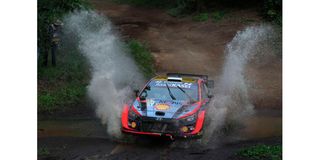Let’s share memorable World Rally Championship moments

Estonia's Ott Tanak navigated by Martine Jarveoja racing on a Hyundai i20 in full cruise during Soysambu stage in Naivasha on June 25,2022 during World Rally Championships Safari Rally Kenya.
What you need to know:
- Safari Rally Kenya has a rich, chequered history if not deeper than any of the other events which have ever been a round of the WRC, beginning with the victory of Hannu Mikkola in 1972
- Each rally has its own history, spills, and thrills
- The website will reveal the 20 greatest moments of the WRC on December 31
World Rally Championship (WRC) website WRC.com has lined up a series of historical stories capturing great moments of the WRC daily, starting Monday until December 31, to celebrate the championships' golden jubilee.
The website has invited readers, Kenyans included, to share their greatest moments of rallies hosted by the WRC, like the Safari Rally, to contribute to the daily instalments.
WRC.com will then invite six expert journalists who will whittle the list down to 50. The website will then reveal the 20 greatest moments of the WRC on December 31.
Each rally has its own history, spills, and thrills. From the mountainous French Alps to the forest jumps of Finland, the snow banks of Sweden, and ultimately the enviable Safari Rally's unique nature, the coming days, as re-lived daily in WRC.com, have created an interactive forum for those who love rallying.
The website re-traces the WRC from its inception in 1972, beginning with Jean-Claude Andruet’s victory in January, 1972, at Monte to the capping of Kalle Rovanpera as the youngest world champion last month.
Safari Rally Kenya has a rich, chequered history if not deeper than any of the other events which have ever been a round of the WRC, beginning with the victory of Hannu Mikkola in 1972.
WRC.com has singled out Safari for its many firsts.
The Commission Sportive Internationale (CSI) of the FIA ratified the International Rally Championship for Makes (IRCM) in 1970 at a time when the reputation of the Safari had reached dizzying and mystical heights across the globe, as the Toughest Rally in the World without an overseas driver champion.
Exploits of 1972
For this reason, the CSI decided to include the East African Safari Rally in the eight events in the IRCM which the CSI felt necessary to give the series its international title and appeal in 1970 together with Rallye Morrocco and Press on Regardless Rally in the United States.
Six foreign professionals, namely Rauno Aaltonen, Sandro Munari, Harry Kallstrom, Simo Lampinen, Dieter Glemser and Sobislaw Zasada, lined up for the 1970 Safari. It should be remembered that Zasada competed in the Safari last year. But his exploits of 1972 remain the stuff of legends.
The WRC for makes came in the background of ordinary cars racing in models like the Ford Cortinas, Zephers, Saabs and Peugeots in the Safari with minimal modification in the 60s era which has its share of great moments like the "Unsinkable Seven" and "Magnificient Seven" number of finishers in 1963 and 67' Safaris.
But from 1970, manufacturers joined the fray with purpose-built powerful cars like the Datsun 240Z, Mercedes, Porsche, Ford Escort, Lancia and Peugeot 504 models, and it's only in Kenya where many of them met their waterloo.
Memorable moments
The Safari has had tons of memorable moments since 1972, many tragic, others hilarious, comical or the ultimate test of man and machine against unforgiving nature.
Zasada returned to Kenya last year aged 91 and was en-route to a meritable finish before a fellow competitor hit him from behind in the last stage.
In 1972, so the story goes, having stayed in the dust of Mikkola’s Ford Escort 1600RS for the better part of the Safari, Zasada finally got his break, or so he thought, after arriving at a control point in Uganda simultaneously with Mikkola.
Both navigators Gunnar Palm and Marien Bien sprinted for the time stamp at the controller’s tent of which the former was faster.
Zasada, in a Porsche 911, must have smelt the desired break from Mikkola because he immediately took off, only to realise that he had left his navigator behind after 16 kilometres, and had to drive back for him which certainly caused him a possible victory because he was only 29 points behind Mikkola at the end.
Winning was everything for Toyota Team Europe even as the Safari was not part of the WRC in 1995, the team entered Ian Duncan in a private Toyota Celica GT4 which suffered serious cross-member failure on day one, and the only person who could fix it was in Norway.
Toyota Kenya bosses managed to reach him on a Friday on a mobile phone, a novelty then.
A charter flight flew him to London from where he boarded a commercial flight to Nairobi. He arrived Saturday morning and was flown by helicopter to Marigat where he fixed the car in minutes. Duncan went on to finish third.
You too can share your memorable moments with the Daily Nation, through the email below.



